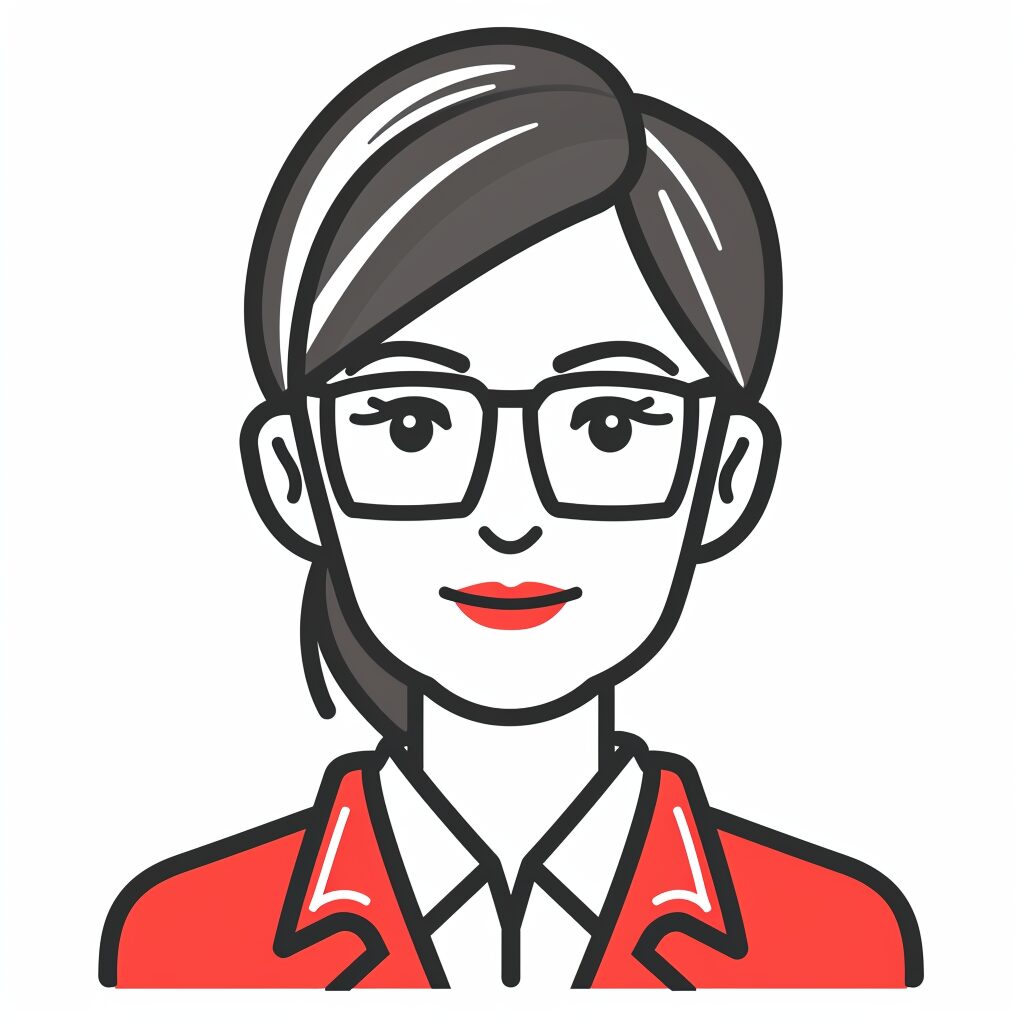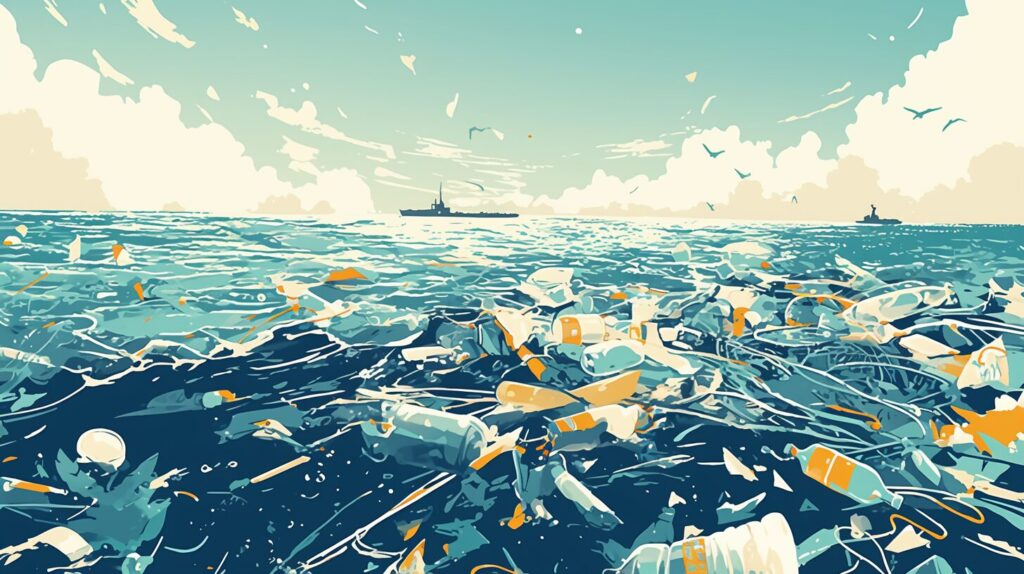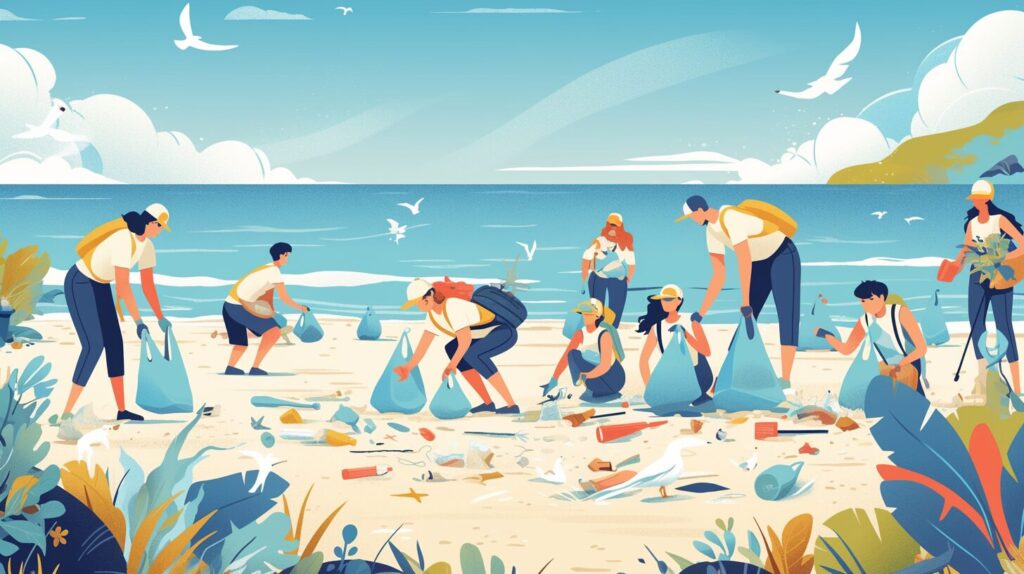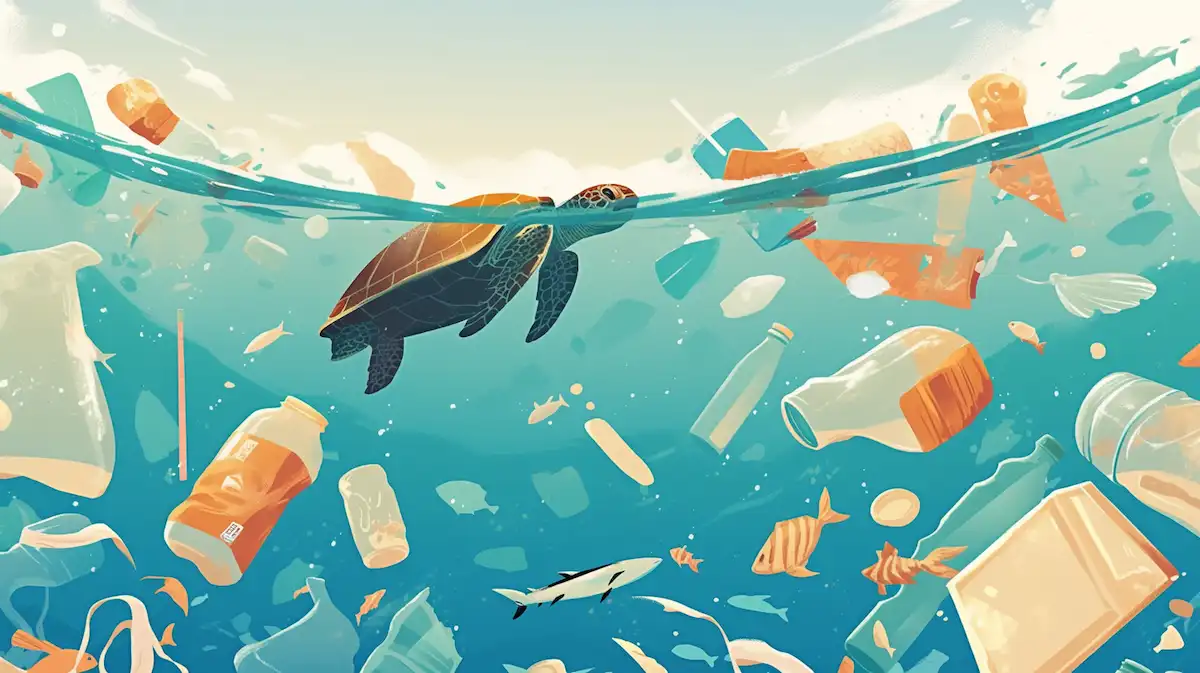海洋プラスチック問題を英語で説明・紹介するための基本情報と、英会話に役立つ表現をシンプルでわかりやすい英語で紹介します。
英会話ダイアローグ・概要・10の質問を通して、海洋プラスチック問題に関する英語表現を学びます。
英語
英会話ダイアローグを読む前に知っておくと良い前提知識と情報です。
- 海洋プラスチック汚染の現状
- 毎年約800万トンのプラスチックが海洋に流出している
- 2050年までに海洋中のプラスチック量が魚の量を上回るという予測がある
- 80%が陸上由来で、残り20%は漁業や船舶由来
- 生態系への影響
- 海洋生物が誤ってプラスチックを摂取する(例:ウミガメがビニール袋をクラゲと間違える)
- 漁網などによる絡まりで年間多くの海洋生物が死亡
- マイクロプラスチックに付着した有害物質が食物連鎖に入り込む
- 人間への影響
- 魚介類や塩、飲料水からマイクロプラスチックが検出されている
- 人間の血液や肺からもマイクロプラスチックが見つかっている
- 健康への長期的影響については研究が進行中
- 解決への取り組み
- The Ocean Cleanupなどのプラスチック回収プロジェクト
- 国連による国際的なプラスチック規制条約の検討
- 各国政府によるレジ袋禁止などの規制強化
- 企業によるサステナブルな代替素材の開発
- 個人でできる対策
- マイバッグ、マイボトル、マイストローの使用
- 適切なごみ分別とリサイクル
- ビーチクリーンなどの清掃活動への参加
- プラスチックフリーの商品選択
- 基本用語
- マイクロプラスチック:
- 5mm以下の小さなプラスチック粒子 のこと
- ペットボトルやビニールが壊れて細かくなったものなど
- 太平洋ゴミベルト:
- 北太平洋に存在する世界最大級のプラスチックごみの集積地
- 使い捨てプラスチック:
- レジ袋、ストロー、ペットボトルなど1回限りの使用を前提としたプラスチック製品
- マイクロプラスチック:
2人が海洋プラスチック問題について話しています。
太平洋ゴミベルトの現状、マイクロプラスチックが食物連鎖に入り込んでいる危険性、使い捨てプラスチック削減や国際的な取り組みの重要性などを話題にしています。
会話 / dialogue
1: Interest in the Topic

Hey Key, I’ve been really interested in marine plastic pollution lately. It seems like a huge problem, but I don’t know much about it.

Yeah, it’s a serious issue. Every year, millions of tons of plastic enter the ocean, and it’s causing a lot of damage. What made you interested in it?

I recently saw a documentary about the Great Pacific Garbage Patch. I was shocked by the amount of plastic floating in the ocean. I had no idea it was that bad.

Yeah, that’s one of the biggest plastic accumulation zones in the world. Ocean currents trap plastic waste in certain areas, and it just keeps growing.
2: The Scale of the Problem

So, how much plastic is actually in the ocean?

Scientists estimate that there are millions of tons of plastic in the sea. If we don’t take action, by 2050, there might be more plastic than fish in the ocean.

That’s terrifying. Where does all this plastic come from?
3: Causes of Marine Plastic Pollution

About 80% of it comes from land. Plastic waste from cities gets carried into rivers and ends up in the ocean.

What about the other 20%?

A lot comes from fishing activities—like lost nets and ropes. Ships and industrial waste also contribute.
4: Impact of Plastic on Marine Life

I heard that plastic is really dangerous for sea animals.

Yeah. Many marine animals mistake plastic for food. Sea turtles often eat plastic bags, thinking they’re jellyfish.

And microplastics? They seem to be everywhere.

Exactly. Microplastics are tiny plastic pieces less than 5mm in size. They come from broken-down plastic waste or from products like facial scrubs.
5: How It Affects Humans

If fish eat microplastics, does that mean we’re eating plastic too?

Unfortunately, yes. Studies have found microplastics in seafood, salt, and even drinking water.

That’s scary. It means this problem affects everyone, not just marine animals.
6: Solutions to Marine Plastic Pollution

So, what can we do about it?

One of the biggest things is reducing single-use plastics—like plastic bags, bottles, and straws.

I already use a reusable bottle, but I should stop using plastic bags too.
7: Government and Corporate Actions

Many countries are banning plastic bags and promoting recycling. Some companies are switching to biodegradable materials.

But recycling doesn’t seem to be very effective.

That’s true. Globally, less than 10% of plastic waste is recycled. That’s why we need better recycling systems and less plastic production in general.
8: New Technologies and International Cooperation

Are there any big projects working on this?

Yeah! There’s a project called The Ocean Cleanup that’s using technology to remove plastic from the sea. Also, the UN is working on a global treaty to control plastic waste.

That’s great! But it sounds like a long process.
9: Final Thoughts and Personal Action

It is. But every small action helps. If more people become aware and change their habits, we can reduce plastic waste.

I’m definitely going to be more careful with plastic. Maybe I’ll even join a beach cleanup.

That’s a great idea! Let’s go to one together next time.

Yeah, let’s do it!
概要 / Overview
「海洋プラスチック問題」について、理解を深めるための「英語での概要」です。
海洋プラスチック問題

What is Marine Plastic Pollution?
Marine plastic pollution is when plastic waste enters the ocean and causes serious environmental problems. Every year, millions of tons of plastic go into the sea. This plastic does not disappear quickly. Instead, it stays in the ocean for many years and harms marine animals, the environment, and even humans.
Where Does the Plastic Come From?
About 80% of ocean plastic comes from land. People throw away plastic bottles, bags, and other waste, which then moves through rivers and reaches the ocean. The other 20% comes from fishing and ships. Fishing nets, ropes, and plastic waste from boats also contribute to the problem.
How Does Plastic Affect Marine Life?
Many sea animals mistake plastic for food. Turtles eat plastic bags because they look like jellyfish. Fish and seabirds eat microplastics, which are tiny plastic pieces smaller than 5mm. These plastics can block their stomachs and cause health problems.
How Does It Affect Humans?
Humans are also affected by plastic pollution. When fish eat microplastics, these plastics enter the human food chain. Scientists have found microplastics in seafood, salt, and even drinking water. This can be harmful to our health.
How Can We Solve This Problem?
We can reduce plastic waste by using reusable bags, bottles, and straws. Governments and companies are working to ban single-use plastics and improve recycling systems. New technology, such as ocean cleanup projects, is also helping to remove plastic from the sea.
By working together, we can reduce plastic pollution and protect our oceans for the future.
10の質問 / 10 questions
「海洋プラスチック問題」について、理解を深めるための「英語での10の質問」です。
1: What is marine plastic pollution?
Marine plastic pollution is the presence of plastic waste in the ocean, causing harm to marine life and ecosystems.
2: How does plastic enter the ocean?
Plastic enters the ocean through various pathways, including improper waste disposal, runoff from land, and direct dumping.
3: What are microplastics?
Microplastics are tiny plastic particles less than 5 millimeters in size, resulting from the breakdown of larger plastic debris or manufactured as small particles.
4: Why are microplastics a concern?
Microplastics are concerning because they can be ingested by marine organisms, potentially causing physical harm and introducing toxic substances into the food chain.
5: What is the Great Pacific Garbage Patch?
The Great Pacific Garbage Patch is a large area in the North Pacific Ocean where a high concentration of plastic debris has accumulated due to ocean currents.
6: How does plastic pollution affect marine life?
Marine animals can ingest plastic debris, leading to internal injuries, starvation, and death. Additionally, animals can become entangled in larger plastic items, impairing their movement and ability to feed.
7: Can plastic pollution impact human health?
Yes, plastic pollution can impact human health, as microplastics have been found in seafood consumed by humans, potentially introducing harmful chemicals into our diet.
8: What role does plastic production play in environmental pollution?
The increasing production of plastic contributes to environmental pollution, as a significant portion of produced plastic is not recycled and ends up in natural habitats, including oceans.
9: Are there international efforts to address plastic pollution?
Yes, international efforts are underway to address plastic pollution, including negotiations for a global treaty to reduce plastic waste and its environmental impact.
10: What can individuals do to reduce marine plastic pollution?
Individuals can reduce marine plastic pollution by minimizing the use of single-use plastics, participating in local clean-up efforts, and supporting policies aimed at reducing plastic waste.

和訳付
会話 / dialogue
1: Interest in the Topic

Hey Key, I’ve been really interested in marine plastic pollution lately. It seems like a huge problem, but I don’t know much about it.
なあキー、最近、海洋プラスチック問題にすごく興味があるんだ。すごく大きな問題みたいだけど、詳しくは知らないんだよね。

Yeah, it’s a serious issue. Every year, millions of tons of plastic enter the ocean, and it’s causing a lot of damage. What made you interested in it?
うん、これは深刻な問題だよ。毎年、何百万トンものプラスチックが海に流れ込んで、かなりの被害を出しているんだ。何がきっかけで興味を持ったの?

I recently saw a documentary about the Great Pacific Garbage Patch. I was shocked by the amount of plastic floating in the ocean. I had no idea it was that bad.
最近、「太平洋ゴミベルト」のドキュメンタリーを見たんだ。海に浮かぶプラスチックの量に衝撃を受けたよ。こんなにひどいなんて知らなかった。

Yeah, that’s one of the biggest plastic accumulation zones in the world. Ocean currents trap plastic waste in certain areas, and it just keeps growing.
そう、それは世界で最大級のプラスチックごみの集積地のひとつだよ。海流がプラスチックごみを特定の場所に集めてしまって、どんどん増えているんだ。
2: The Scale of the Problem

So, how much plastic is actually in the ocean?
それで、実際にどのくらいのプラスチックが海にあるの?

Scientists estimate that there are millions of tons of plastic in the sea. If we don’t take action, by 2050, there might be more plastic than fish in the ocean.
科学者によると、海には何百万トンものプラスチックがあるって言われてる。何もしなければ、2050年には海のプラスチックの量が魚の量を超えるかもしれないんだ。

That’s terrifying. Where does all this plastic come from?
それって怖すぎるよ。こんなにたくさんのプラスチックはどこから来るの?
3: Causes of Marine Plastic Pollution

About 80% of it comes from land. Plastic waste from cities gets carried into rivers and ends up in the ocean.
約80%は陸から来ているんだ。都市のプラスチックごみが川に流れて、最終的に海にたどり着くんだよ。

What about the other 20%?
残りの20%は?

A lot comes from fishing activities—like lost nets and ropes. Ships and industrial waste also contribute.
多くは漁業活動によるものだよ。例えば、なくなった漁網やロープとかね。船や工場からの廃棄物も影響している。
4: Impact of Plastic on Marine Life

I heard that plastic is really dangerous for sea animals.
プラスチックって海の生き物にとってすごく危険だって聞いたことがあるよ。

Yeah. Many marine animals mistake plastic for food. Sea turtles often eat plastic bags, thinking they’re jellyfish.
そうなんだ。多くの海洋生物がプラスチックを食べ物と間違えちゃうんだよ。ウミガメなんかは、クラゲと勘違いしてビニール袋を食べてしまうことがよくあるんだ。

And microplastics? They seem to be everywhere.
それにマイクロプラスチック。あれってどこにでもあるみたいだよね?

Exactly. Microplastics are tiny plastic pieces less than 5mm in size. They come from broken-down plastic waste or from products like facial scrubs.
その通り。マイクロプラスチックは5mm以下の小さなプラスチック片のことだよ。壊れたプラスチックごみや、洗顔料なんかにも入っているんだ。
5: How It Affects Humans

If fish eat microplastics, does that mean we’re eating plastic too?
魚がマイクロプラスチックを食べるなら、僕たちもそれを食べてるってこと?

Unfortunately, yes. Studies have found microplastics in seafood, salt, and even drinking water.
残念だけど、そうなんだ。研究によると、海産物や塩、さらには飲み水にまでマイクロプラスチックが含まれているんだよ。

That’s scary. It means this problem affects everyone, not just marine animals.
それは怖いね。この問題は海の生き物だけじゃなく、みんなに影響を与えるってことだね。
6: Solutions to Marine Plastic Pollution

So, what can we do about it?
それで、僕たちに何ができるの?

One of the biggest things is reducing single-use plastics—like plastic bags, bottles, and straws.
一番大きなことは、使い捨てプラスチックを減らすことだね。例えば、レジ袋やペットボトル、ストローとか。

I already use a reusable bottle, but I should stop using plastic bags too.
もうマイボトルを使ってるけど、ビニール袋もやめるべきだね。
7: Government and Corporate Actions

Many countries are banning plastic bags and promoting recycling. Some companies are switching to biodegradable materials.
多くの国では、ビニール袋を禁止したり、リサイクルを推進したりしているよ。企業の中には、生分解性の素材に切り替えているところもある。

But recycling doesn’t seem to be very effective.
でも、リサイクルってあまり効果がないように感じるよ。

That’s true. Globally, less than 10% of plastic waste is recycled. That’s why we need better recycling systems and less plastic production in general.
その通り。世界的に見ると、プラスチックごみのリサイクル率は10%未満なんだ。だから、より良いリサイクルシステムや、そもそもプラスチックの生産を減らす必要があるんだ。
8: New Technologies and International Cooperation

Are there any big projects working on this?
これに取り組んでいる大きなプロジェクトってあるの?

Yeah! There’s a project called The Ocean Cleanup that’s using technology to remove plastic from the sea. Also, the UN is working on a global treaty to control plastic waste.
あるよ!「オーシャン・クリーンアップ」っていうプロジェクトがあって、海のプラスチックを除去する技術を使っているんだ。それに、国連もプラスチック廃棄物を規制するための国際条約を進めているよ。

That’s great! But it sounds like a long process.
それはすごいね!でも、時間がかかりそうだな。
9: Final Thoughts and Personal Action

It is. But every small action helps. If more people become aware and change their habits, we can reduce plastic waste.
そうなんだ。でも、小さな行動が大きな違いを生むよ。もっと多くの人が問題を知って、生活習慣を変えれば、プラスチックごみを減らせるはず。

I’m definitely going to be more careful with plastic. Maybe I’ll even join a beach cleanup.
僕もプラスチックの使い方にもっと気をつけるよ。ビーチクリーンアップに参加するのもいいかも。

That’s a great idea! Let’s go to one together next time.
それはいい考えだね!今度一緒に行こうよ。

Yeah, let’s do it!
うん、ぜひやろう!
概要 / Overview
海洋プラスチック問題

What is Marine Plastic Pollution?
Marine plastic pollution is when plastic waste enters the ocean and causes serious environmental problems. Every year, millions of tons of plastic go into the sea. This plastic does not disappear quickly. Instead, it stays in the ocean for many years and harms marine animals, the environment, and even humans.
海洋プラスチック問題とは?
海洋プラスチック問題とは、プラスチックごみが海に流れ込み、深刻な環境問題を引き起こすことです。毎年、何百万トンものプラスチックが海に流入しています。プラスチックはすぐには分解されません。そのため、何年も海に残り続け、海の生き物や環境、さらには人間にも悪影響を与えます。
Where Does the Plastic Come From?
About 80% of ocean plastic comes from land. People throw away plastic bottles, bags, and other waste, which then moves through rivers and reaches the ocean. The other 20% comes from fishing and ships. Fishing nets, ropes, and plastic waste from boats also contribute to the problem.
プラスチックはどこから来るのか?
海に流れ込むプラスチックの約80%は陸地からです。人々が捨てたペットボトルやビニール袋などのごみが川を通じて海に流れ込みます。残りの20%は漁業や船からです。漁網やロープ、船からのプラスチックごみも問題を引き起こしています。
How Does Plastic Affect Marine Life?
Many sea animals mistake plastic for food. Turtles eat plastic bags because they look like jellyfish. Fish and seabirds eat microplastics, which are tiny plastic pieces smaller than 5mm. These plastics can block their stomachs and cause health problems.
プラスチックは海洋生物にどのような影響を与えるのか?
多くの海の生き物は、プラスチックを食べ物と間違えます。ウミガメはビニール袋をクラゲと勘違いして食べてしまうことがあります。魚や海鳥は、5mm以下の小さなプラスチック(マイクロプラスチック)を食べてしまうこともあります。これが消化器官を詰まらせ、健康に悪影響を与えるのです。
How Does It Affect Humans?
Humans are also affected by plastic pollution. When fish eat microplastics, these plastics enter the human food chain. Scientists have found microplastics in seafood, salt, and even drinking water. This can be harmful to our health.
プラスチックは人間にどのような影響を与えるのか?
人間も海洋プラスチック問題の影響を受けています。魚がマイクロプラスチックを食べると、それが食物連鎖を通じて人間の体内に入る可能性があります。科学者たちは、海産物や塩、さらには飲み水の中にもマイクロプラスチックが含まれていることを発見しました。これは私たちの健康に悪影響を及ぼす可能性があります。
How Can We Solve This Problem?
We can reduce plastic waste by using reusable bags, bottles, and straws. Governments and companies are working to ban single-use plastics and improve recycling systems. New technology, such as ocean cleanup projects, is also helping to remove plastic from the sea.
この問題をどのように解決できるか?
私たちはマイバッグ、マイボトル、マイストローを使うことでプラスチックごみを減らすことができます。政府や企業は使い捨てプラスチックの禁止やリサイクルシステムの改善に取り組んでいます。また、海洋ごみを回収するための新しい技術(オーシャン・クリーンアップ・プロジェクトなど)も活用されています。
By working together, we can reduce plastic pollution and protect our oceans for the future.
協力することで、プラスチック汚染を減らし、未来の海を守ることができます。
10の質問 / 10 questions
1: What is marine plastic pollution?
海洋プラスチック汚染とは何ですか?
Marine plastic pollution is the problem of plastic waste entering the ocean and harming marine life and ecosystems. It includes plastic bags, bottles, and fishing nets that do not break down easily in nature.
海洋プラスチック汚染とは、プラスチックごみが海に入り、海洋生物や生態系に害を及ぼす問題です。これには、自然界で簡単に分解されないビニール袋、ペットボトル、漁網などが含まれます。
2: How does plastic enter the ocean?
プラスチックはどのようにして海に入るのですか?
Plastic waste enters the ocean through rivers, wind, and human activities such as littering and improper waste disposal. Some plastic also comes from fishing boats and shipping accidents.
プラスチックごみは、川や風、人間の活動(ポイ捨てや不適切なごみ処理)を通じて海に入ります。また、漁船や輸送中の事故からも流出することがあります。
3: What are microplastics?
マイクロプラスチックとは何ですか?
Microplastics are tiny plastic particles, less than 5mm in size. They come from broken-down plastic waste or are intentionally made small, such as in cosmetics and cleaning products.
マイクロプラスチックは、5mm以下の小さなプラスチック粒子のことです。これらは、大きなプラスチックごみが分解されたものや、化粧品や洗剤の中に含まれる微細なプラスチックとして意図的に作られたものです。
4: Why are microplastics a concern?
なぜマイクロプラスチックは問題なのですか?
Microplastics can be eaten by marine animals, causing internal damage or poisoning. They also enter the human food chain through seafood, which may be harmful to our health.
マイクロプラスチックは海洋生物に食べられ、内臓を傷つけたり、有害物質を取り込んだりする可能性があります。また、魚介類を通じて人間の食物連鎖にも入り込み、健康に悪影響を及ぼす可能性があります。
5: What is the Great Pacific Garbage Patch?
太平洋ゴミベルトとは何ですか?
The Great Pacific Garbage Patch is a large area in the Pacific Ocean where plastic waste accumulates due to ocean currents. It is one of the biggest marine pollution zones in the world.
太平洋ゴミベルトは、海流の影響でプラスチックごみが集まり続ける太平洋の広大なエリアです。これは世界最大級の海洋汚染地域のひとつです。
6: How does plastic pollution affect marine life?
プラスチック汚染は海洋生物にどのような影響を与えますか?
Many marine animals mistake plastic for food and eat it, which can cause choking, digestive problems, or death. Others get trapped in plastic waste, making it hard for them to move or hunt.
多くの海洋生物はプラスチックを食べ物と間違えて食べてしまい、窒息、消化器系の問題、死亡につながることがあります。また、プラスチックごみに絡まって動けなくなったり、狩りができなくなったりする生物もいます。
7: Can plastic pollution impact human health?
プラスチック汚染は人間の健康に影響を与えることがありますか?
Yes, microplastics have been found in seafood, salt, and drinking water. Some chemicals in plastics can be toxic and may cause health problems when they enter the human body.
はい。マイクロプラスチックは魚介類、塩、飲料水の中から発見されています。プラスチックに含まれる化学物質の中には有毒なものもあり、体内に取り込まれると健康に悪影響を与える可能性があります。
8: What role does plastic production play in environmental pollution?
プラスチックの生産は環境汚染にどのような影響を与えますか?
Plastic production uses fossil fuels and releases greenhouse gases, contributing to climate change. Many plastic products are not recycled and end up polluting land and oceans.
プラスチックの生産には化石燃料が使われ、温室効果ガスを排出するため、気候変動の原因になります。また、多くのプラスチック製品はリサイクルされず、最終的に土地や海を汚染します。
9: Are there international efforts to address plastic pollution?
プラスチック汚染を解決するための国際的な取り組みはありますか?
Yes, the United Nations and many countries are working on agreements to reduce plastic waste. Some countries have banned plastic bags and are promoting recycling programs.
はい。国連や多くの国々がプラスチックごみを減らすための協定を進めています。すでに使い捨てプラスチックの禁止や、リサイクルを促進する政策を導入している国もあります。
10: What can individuals do to reduce marine plastic pollution?
個人が海洋プラスチック汚染を減らすためにできることは何ですか?
Individuals can use reusable bags and bottles, avoid single-use plastics, recycle properly, and participate in beach cleanups to help remove plastic waste from the environment.
個人でできることには、マイバッグやマイボトルの使用、使い捨てプラスチックの使用を避けること、正しくリサイクルすること、ビーチクリーン活動に参加してプラスチックごみを回収することなどがあります。

words & phrases
英会話ダイアローグと関連情報に出てきた単語・フレーズです(例文は各3つ)。

current : 名詞
意味: 「流れ」「現在の状態」。A continuous movement of water, air, or electricity. Also means something happening now.
(海流(ocean current)として使われ、プラスチックごみが流される仕組みを説明する際に使用)
例文:
- The current in the ocean carries plastic waste to different places.
「海の流れはプラスチックごみをさまざまな場所へ運びます。」 - He swam against the current, which was very strong.
「彼はとても強い流れに逆らって泳いだ。」 - The current in the river is faster after heavy rain.
「大雨の後、川の流れは速くなる。」
trap : 動詞
意味: 「閉じ込める」「罠にかける」。To catch and hold something so that it cannot escape.
(海流がプラスチックごみを特定の場所に集めてしまうという文脈で使用)
例文:
- Ocean currents trap plastic waste in certain areas.
「海流がプラスチックごみを特定の場所に閉じ込めます。」 - The small fish got trapped in the fishing net.
「小さな魚が漁網に閉じ込められた。」 - He was trapped in an elevator during the power outage.
「彼は停電中にエレベーターの中に閉じ込められた。」
take action : フレーズ
意味: 「行動を起こす」。To do something to solve a problem or change a situation.
(海洋プラスチック問題に対して行動を起こす必要があることを強調する際に使用)
例文:
- We must take action to reduce plastic waste.
「私たちはプラスチックごみを減らすために行動を起こさなければなりません。」 - The government needs to take action against pollution.
「政府は汚染対策に取り組む必要があります。」 - If we don’t take action, the problem will get worse.
「もし私たちが行動を起こさなければ、問題はさらに悪化するでしょう。」
terrifying : 形容詞
意味: 「非常に恐ろしい、ぞっとするほど怖い」。Extremely scary or frightening.
(非常に深刻で恐ろしい状況を表すために使用)
例文:
- The idea of more plastic than fish in the ocean is terrifying.
「海のプラスチックが魚より多くなるという考えは恐ろしい。」 - The storm was terrifying, with strong winds and huge waves.
「その嵐は強風と巨大な波でとても恐ろしかった。」 - She had a terrifying experience when she got lost in the forest.
「彼女は森で迷ったとき、とても怖い体験をした。」
scary : 形容詞
意味: 「怖い、恐ろしい」。Something that makes you feel afraid.
(怖いと感じる状況を表すために使用)
(「terrifying」よりも日常的に使われ、程度がやや軽い)
例文:
- It is scary to think that we are eating plastic through seafood.
「魚介類を通じてプラスチックを食べていると考えると怖い。」 - The horror movie was really scary.
「そのホラー映画は本当に怖かった。」 - Walking alone at night in a strange city can be scary.
「知らない街で夜に一人で歩くのは怖いこともある。」
